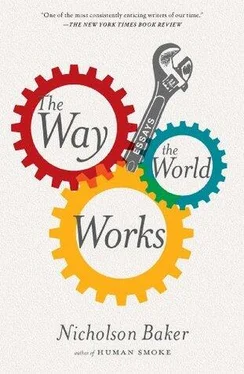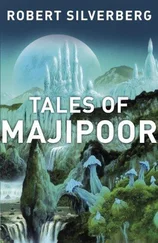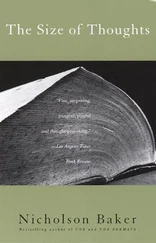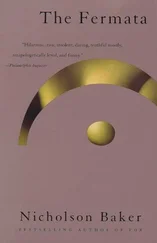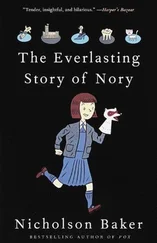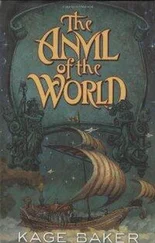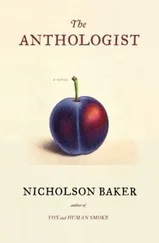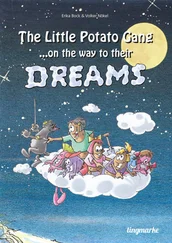Nicholson Baker - The Way the World Works
Здесь есть возможность читать онлайн «Nicholson Baker - The Way the World Works» весь текст электронной книги совершенно бесплатно (целиком полную версию без сокращений). В некоторых случаях можно слушать аудио, скачать через торрент в формате fb2 и присутствует краткое содержание. Год выпуска: 2012, Издательство: Simon & Schuster, Жанр: Публицистика, Критика, на английском языке. Описание произведения, (предисловие) а так же отзывы посетителей доступны на портале библиотеки ЛибКат.
- Название:The Way the World Works
- Автор:
- Издательство:Simon & Schuster
- Жанр:
- Год:2012
- ISBN:нет данных
- Рейтинг книги:4 / 5. Голосов: 1
-
Избранное:Добавить в избранное
- Отзывы:
-
Ваша оценка:
- 80
- 1
- 2
- 3
- 4
- 5
The Way the World Works: краткое содержание, описание и аннотация
Предлагаем к чтению аннотацию, описание, краткое содержание или предисловие (зависит от того, что написал сам автор книги «The Way the World Works»). Если вы не нашли необходимую информацию о книге — напишите в комментариях, мы постараемся отыскать её.
), here assembles his best short pieces from the last fifteen years.
The Way the World Works
OED
Modern Warfare 2
Through all these pieces, many written for
, and
, Baker shines the light of an inexpugnable curiosity.
is a keen-minded, generous-spirited compendium by a modern American master.
The Way the World Works — читать онлайн бесплатно полную книгу (весь текст) целиком
Ниже представлен текст книги, разбитый по страницам. Система сохранения места последней прочитанной страницы, позволяет с удобством читать онлайн бесплатно книгу «The Way the World Works», без необходимости каждый раз заново искать на чём Вы остановились. Поставьте закладку, и сможете в любой момент перейти на страницу, на которой закончили чтение.
Интервал:
Закладка:
Then, when I was six, we — that is, my sister, Rachel, my father and mother — moved to a house on Highland Avenue. It had a newel post on the front banister that was perfect for threading the front hall and living room, which I did several times, and it had a porte cochere and six bathrooms, a few of which worked, and it had an old wooden telephone in the hall closet that connected to another telephone in a room in the garage. The phone was dead, as my sister and I verified by shouting inaudible questions into either end, but there were interestingly herringboned threads woven as insulation around its cord, and because the phone had never been much used, the threads weren’t frayed.
Highland Avenue was, as it turned out, also a perfect length of street, just as Strathallan had been, but in the opposite way: it went on forever. In one direction it sloped past Cobbs Hill Drive, where I always turned left when I walked to school, and then past the lawn-and-garden store, where my father bought prehistoric sedums every Sunday; and then it just kept on going. In the other direction it ran past our neighbors’ houses, the Collinses, the Cooks, the Pelusios, and the Eberleins, and past a suburban-looking house on the left, and then it became quite a narrow street without sidewalks that just flowed on and on, who knew where. On Strathallan, our house number had been 30; now it was 1422, meaning that there must have been over a thousand houses on our street. In fact, it wasn’t even called a street; it was an avenue. Avenues were, I gathered, more heavily trafficked, and therefore more important, than streets — Monroe Avenue, East Avenue, Lyell Avenue, Highland Avenue — they reached into surrounding counties and countries, and because the world was round, their ends all joined up on the other side. I was quite pleased to be part of something so infinite.
Soon after we moved in, my grandparents gave us a hammock made of green and white string. We hung it from two hooks on the front porch, and I lay in it looking at the fragment of Highland Avenue that I saw through the stretched fretwork of its strings. I could hear a car coming long before I could see it, and as it passed, its sound swooshed up the driveway toward me like a wave on a beach. That’s when I counted it. One day I counted a thousand cars while lying on that hammock. It took about half an hour or so — a thousand wasn’t as close to infinity as I’d thought it was.
And Cobbs Hill Park, half a block from where we lived, was, I discovered, one of the best kite-flying places in the city. My father was able to put a box kite in the air, which I never could; once it was up it was like a rock, unmoving, nailed to the sky. The key to kite flying, I found, was that you needed to lick your finger a lot and hold it in the air, and you always had to buy more rolls of string than you thought you needed, because the string manufacturers cheated by winding their product in open crisscrossing patterns around an empty cardboard cylinder — it looked as if you were holding a ball of string that was miles long, but in fact it was only eight hundred feet, which was nothing. One way or another, we always ran out of string.
To put myself to sleep at night, I began thinking about kites that never had to come down. I would add more string, half a dozen rolls of it, and when I knew the kite was steady, I would tie my end to a heavy ring in the ground that couldn’t pull away and then I would shinny up the kite line with sticks in my pockets. I’d climb until I was a good ways up, and then I would make a loop around one foot to hold some of my weight, and begin knotting a sort of tree house out of the kite string to which I clung. The kite would be pulled down a little as I worked, but it was so far up in the sky that the loss of height didn’t matter much, and I would use the sticks that I’d brought along as braces or slats around which I would weave the string, emulating our hammock’s texture, until I had made a small, wind-shielding crow’s nest like the basket in a hot-air balloon. I would spend the night up there, and the next morning, as people arrived in the park with their kites, they would point up at me and be impressed.
But that was just how I got to sleep; my biggest real moment of Cobbs Hill kite flying came around 1966, when I was nine. I was given a bat-shaped kite that year. It came from England via Bermuda in a long cardboard box that said “Bat Kite.” The wings were made of black, slightly stretchy vinyl, with four wooden dowels as braces, a fiberglass crosspiece, and a triangle of vinyl with a metal grommet in it, where you tied the string. It was entirely black, a beautiful kite, but I wasn’t able to get it up in the air for more than a few minutes because it was so heavy.
Then one weekend my old tricycle rival, Fred Streuver, and I went up to Cobbs Hill on a day when there was a hard steady wind blowing in from Pittsford Plaza, and the bat kite went up and it stayed up. We were stunned. What had we done right? We began feeding out the string. The kite seemed to want to stay up in the sky. Nothing we could do would bother it. It was hungry for string and it kept pulling, wanting to go out farther, over the path near the tennis courts. I tied on another roll, checking to be sure that I’d made a square knot — the kind that gets stronger and tighter the harder you pull on it. Our black bat was now out past the lilac bushes near Culver Road, and it was high high in the air, visible all over Rochester — hundreds of people could see it — and then we tied on another roll, and it was out beyond Culver Road and still asking for more string.
I had an almost frightened feeling — I was holding directly on to something that was alive and flying and yet far away. Having thought my way out to the empty air where the kite was, I almost forgot how to balance as I stood on the grass of Cobbs Hill. Even the square knots that we had tied had risen out of sight — the string was getting more and more infinite every minute.
Then, as always, we ran out. But we wanted more. We wanted our bat to go a full mile out. Fred held the line as I gathered a length of scrap string that some departed fliers had left behind; I tied it on, even though it had a nested tangle in it that held a twig, and the kite kept pulling. I found another abandoned string, but here Fred and I were overhasty when we tied the knot, we were laughing crazily by now, we were tired, and neither of us was checking each other’s work. We sent up the new string, but when it had gone just out of reach, I saw a tiny unpleasant movement in the knot. It was a writhing sort of furtive wiggle. I said, “No, bring it down!” and I grabbed the line, but the kite’s pull was too strong, and the flawed knot shrugged off the rest of its loops — it had been, I now saw, a granny knot. The string that we held went limp, and the string on the other side of the failed knot went limp as well, and floated sideways.
Way off beyond Culver Road, the kite learned the truth all at once: it flung itself back some feet as if pushed or shot, and its bat wings flapped like loose sails, and then it slid down out of the sky into some trees that were beyond other trees, that were beyond houses, that were beyond trees.
We went looking for it, but it was gone. It had fallen somewhere in a neighborhood of short streets, in one of a hundred little back yards.
(2003)
Coins
In 1973, when I was sixteen, I got a job in building maintenance at Midtown Plaza, Rochester’s then flourishing downtown shopping mall. I spent a day pulling nails from two-by-fours — loudly whistling Ravel’s Boléro while I worked, so that the secretaries would know that I knew a few things about French music — and then Rocky, the boss, a dapper man with a mustache, apprenticed me to the mall’s odd-job man, Bradway. Bradway taught me the right way to move filing cabinets (you walk with them on alternating corners, as if you’re slow dancing with them, and when you have one of them roughly in position in its row, just put the ball of your foot low against a corner and step down, and the cabinet will slide into place as if pulled there by a magnet); and he taught me how to snap a chalk line, how to cut curves in Sheetrock, how to dig a hole for a “No Parking” sign, how to adjust the hydraulic tension on an automatic door, the right way to use a sledgehammer, and how to change the fluorescent bulbs in the ceiling of the elevator. He wore funny-looking glasses, and he sang “Pretty, Pretty Paper Doll” to the secretaries, embarrassing them and me, but he was a decent person and a good teacher. For reasons I still don’t understand he was disliked by one of the carpenters in the maintenance department, who referred to him as a “proctologist’s delight.”
Читать дальшеИнтервал:
Закладка:
Похожие книги на «The Way the World Works»
Представляем Вашему вниманию похожие книги на «The Way the World Works» списком для выбора. Мы отобрали схожую по названию и смыслу литературу в надежде предоставить читателям больше вариантов отыскать новые, интересные, ещё непрочитанные произведения.
Обсуждение, отзывы о книге «The Way the World Works» и просто собственные мнения читателей. Оставьте ваши комментарии, напишите, что Вы думаете о произведении, его смысле или главных героях. Укажите что конкретно понравилось, а что нет, и почему Вы так считаете.
